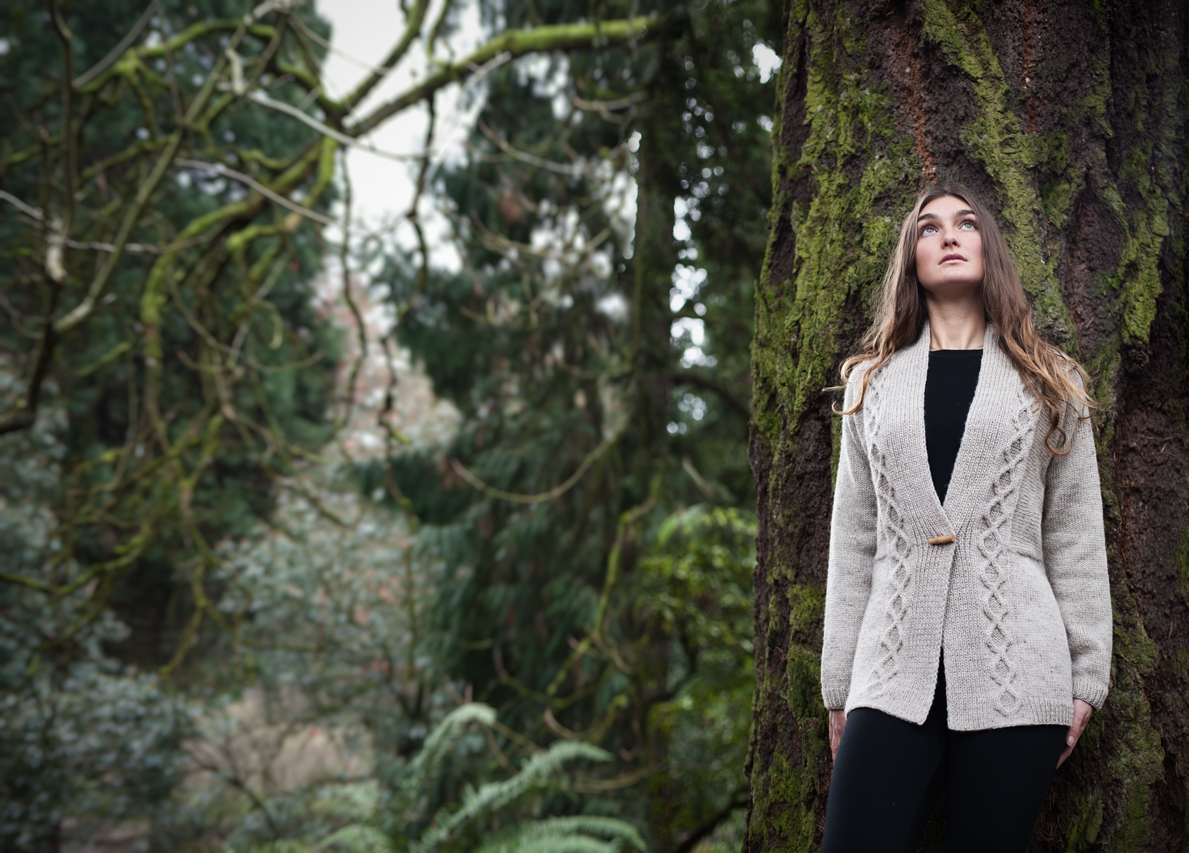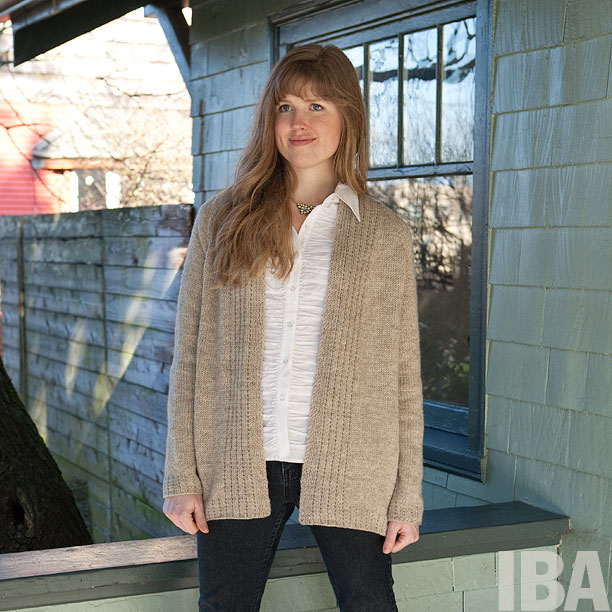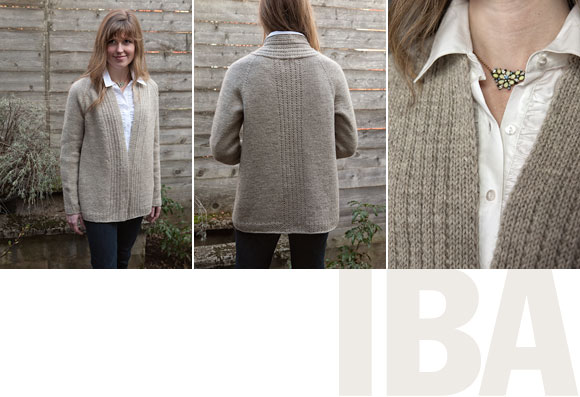Even though it’s evident that cabin fever is rapidly rampaging into full-blown spring fever here at Studio Chic, the temperature reality of the Pacific Northwest is in what is know as February Fake-out.
During the day, in the sun, there can be a feeling that something is indeed sprung, but in the shade or once the sun goes down, I am still reaching for my toasty woolies…
And I’m still on a top-down Stockinette Stitch bender! My lovely natural “black” Cormo sweater is blocking (pictures soon), and I’ve started another deep-stash project.
This time out, I’m designing a top-down, chunky (4st/in) gauge sweater that I hope to wear gardening and hiking in the woods.

The Yarn: Rowan Scottish Tweed Aran that I’ve had forever – now discontinued – which is a really rustic, beautifully colored fiber in a deep navy popped with white, grey & cobalt nubs.
The Problem: the receipt from years ago (wow – 2008) says I have 8 balls, but I can only find 7. Hmm… This is a wrench-in-the-works because the comfort zone of my project has just evaported into the chill late winter air.
I want to make a size slightly larger than I normally wear, for comfort and to accommodate the larger gauge, with a length of about 29″, pockets AND a generous shawl collar. But do I have enough yarn?
WHAT TO DO?
Well, first of all, I just had a pretty successful outing with my Cormo sweater, another project where there was a challenge (unknown skein yardages), and I’m ready to
Take It To the Next Level.
(Who said knitting isn’t dangerous?)
The Plan
While working my mystery yardage Cormo sweater, I worked segments of the sweater, putting some areas on hold partway through their creation (the Body) and then knitting other important segments (the Sleeves). I knew I had enough yarn for an entire sweater but I wanted to make its Body as long as possible. The sweater had a built-in button band, so once the Sleeves were complete I could confidently just knit the yarn until it was gone.
My guesstimates for this new project is that it will take 4 balls for the Yoke/Body; 1 ball for each Sleeve; and 1 ball for the Shawl collar & bands, which is not built-in but worked last. Oof…
But here is a plan I think will allow me to knit and pause and change segments to carefully try and ration my yardage successfully:
1. Yoke
2. Body (for one ball after Sleeve divide – then put on scrap yarn to hold)
3. Sleeves
4. Complete the Body
5. Collar/Bands
6. (optional) Pockets – either patch or afterthought depending on leftovers from 1-5
Working this way, I could track the yarn usage and adjust #4’s length to make sure I could at least complete #5.
First Things First
Since starting to bake serious sourdough bread, I’ve acquired something no kitchen (or knitter) should be without: a inexpensive scale.
This tool will be the keystone to figuring out if I can bring my project to the finish line.
It will enable me to find a basis to keep track and distribute the use of the actual balls I have across the garment.
What information does the scale help discover?
Well, the most important: how much length is used per weight.
With that data, and the given yardage put-up of the yarn, one can figure out how much area and length you can expect to get from each ball and scale its usage accordingly.
Quick Math
This particular yarn has 186 yards per 100 grams.
Bringing this into U.S. standards of measurement of inches/oz means, using straight algebra where 100g converts to 3.523oz
3.523oz / 186yds = 1oz / x  where x is the yardage per oz
where x is the yardage per oz
OR more directly – all this means is you divide the yardage of the ball by its weight:
186/3.523
So: each ounce of yarn has about 52.8 yards
Start it Up
Now a more sane person might’ve taken this one step further, and if you’re interested in really understanding the A-Z of this, I encourage you to try this: make a large swatch and keep track of stitches and rows worked at your desired gauge.
Then: weigh the swatch, and divide it by the number of total stitches made (stitches per row TIMES number of rows worked).
This will give you the length of yarn used per stitch, which can be a very useful piece of information in this process.
But because I’m an adventurer, I just cast right on and I am going to keep track of the number of stitches worked on the Yoke as I go through the first ball of yarn (with pencil and paper), using the same concept as above.
Doing this, I find that I am using approximately 1″ of yarn for every stitch worked. Sweet! An easy nice number! I will call this data into play later on in the garment.
Now the second ball of yarn I’m using takes me through the Yoke divide (where you put the Sleeves on hold in top-down construction) and now the Body is basically a rectangle and it’s very easy to keep track of that important “stitches worked” count.
My initial estimate of 1″ per stitch checks out again and I put the Body on hold and start working the first sleeve.
The Payoff
My most scary segment of this design is the Shawl Collar/Bands. It is the hardest to guesstimate area and yardage. The longer I make the sweater, the more yarn it will take to band it.
I’m hoping to gain a little more confidence by completing the Sleeves and having a little leftover yarn for insurance. Eyeballing the Body section I’ve worked already also helps – I can visualize the collar/bands within its area and know it’s probably going to take at least a ball.
After I’m done with the first Sleeve, I now go back to my scale and weigh the remaining yarn.

The leftover ball weighs .65oz.
I know I have 52.8 yards per oz – so that’s about 34 yards.
So, from the two sleeves, that means I’ll have 68 yards extra.
BONUS!
On to Sleeve Two.
…to be continued – stay tuned…






